US: Wal-Mart maps out grand plan to go greener
Wal-Mart will set out how it will cut costs by measuring and reducing greenhouse gas emissions throughout its supply chain Monday.
The company believes its suppliers can substantially reduce their costs, particularly from energy use, by measuring carbon dioxide output.
Jim Stanway, head of the retailer's greenhouse gas strategy, explained: "The more we learn here, the more there's real business and consumer opportunity, in that there's a lot of unharvested efficiencies yet.
"When you look back at the supply chain and at factories and warehouses and you start thinking about their basic needs for energy . . . there's a huge opportunity to do some relatively simple things to save energy," he said. "We hope to. . . help suppliers get the costs of the carbon out of the system."
Wal-Mart cites Dana Undies, a small Georgia-based manufacturer of children's underwear employing 165, which nearly halved its electricity bills through energy-saving measures suggested by Wal-Mart engineers.
Through a pilot with about 30 other suppliers, four to five in each of seven product categories running from DVDs to vacuum cleaners and beer, Wal-Mart hopes to build a reporting system that can eventually be rolled out to the company's whole supplier base of more than 60,000 companies.
Greenhouse gas emissions reporting is not mandatory under any stock exchange rules, but there have been recent unsuccessful attempts by some institutional investors to make it so.
Paul Dickinson, chief executive of the Carbon Disclosure Project, a collaboration between 315 institutional investors with more than $41,000bn under management, said more companies were undertaking to measure and report their emissions.
About 77 per cent of FT500 companies reported their emissions to the CDP this year. He said: "There is a growing trend for companies to start reporting their emissions. It's good news for investors."
But US companies are less likely to report their emissions than their European counterparts. The CDP received responses from only 56 per cent of the SP500.
Altogether, the CDP sent out requests to 2,400 companies to report their emissions and received responses from about 1,300. The CDP said among the large companies that did not reply were Berkshire Hathaway, Apple Computer, Philips Electronics and Gazprom.
Wal-Mart's example is likely to encourage more companies to do so, he said.
Kert Davies, climate change expert at Greenpeace USA, said Wal-Mart's scale means it could "put pressure on a huge proportion of the economy pretty quickly [to report emissions] . . . . It will help educate companies about their environmental responsibilities, ahead of the introduction of government regulation, which is inevitable," he says.
There are several standards available for reporting on greenhouse gas emissions. The CDP standard is widely used, but some companies have also developed their own methods.
But many companies outside the world's very biggest publicly-listed businesses have been reluctant to disclose their greenhouse gas emissions.
Rory Sullivan, Head of Investor Responsibility at Insight Investment, said there were many reasons for this, ranging from a misconception that such reporting was costly and difficult, to a fear that such information could be used by competitors. But he said investors could gain valuable insights from such reporting, including an assessment of a company's exposure to "climate change risk".
Mr Dickinson said reporting emissions was now straightforward: "It's perfectly possible now for companies to get an accurate fix on their greenhouse gas emissions. All companies can do this."
- 204 Manufacturing



